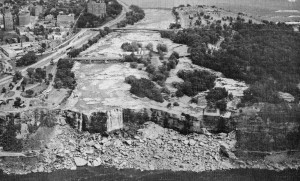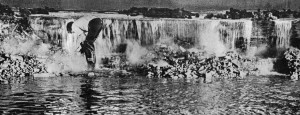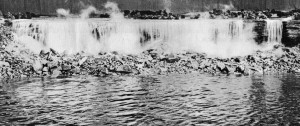- Home
- Niagara Falls Hotels
- Restaurants
- Casinos
- Niagara Falls Shut Off
- Niagara Falls USA
- Aquarium of Niagara Falls
- Goat Island
- Lewiston
- Lockport Caves
- Niagara Falls Cave of the Winds
- Niagara Falls Culinary Institute
- Fashion Outlets of Niagara Falls
- Niagara Falls Observation Tower
- Niagara Falls State Park
- Niagara Fishery
- Niagara Gorge Discovery Center
- Niagara Power Vista
- Maid of the Mist
- Oakwood Cemetery
- Old Fort Niagara
- Rainbow Bridge
- Niagara Falls Canada
- Daredevils
- Links
Niagara Falls News
Lost Lollie Found!

Dorothy said it best – “There’s no place like home” and that is where Lollie, the pretty little dog whose story captivated so many people of Niagara Falls has finally come to rest. After a long 34 days of wandering Grand Island and Niagara Falls in the harsh WNY winter, sweet little Lollie is back home in the loving arms of the amazing woman who saved her from the mean streets of the Bahamas just months ago.
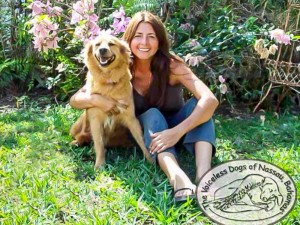
Lollie with Chella Melnechuk
In September, Lollie and her young pups had been nabbed in a catch, spay and release program. While the babies easily found foster homes, it’s much more difficult for the adult dog. Most are just released back onto the streets to continue to fend for themselves.
Newly spayed and sick with heartworm, ehrlichia, parasites and plenty of fleas and ticks, Lollie was about to be another statistic. Then appeared her guardian angel, in the form of Chella Melnechuk. It was obvious to Chella that this little dog was in dire need of a savior, as are so many other homeless wandering the streets of the beautiful islands of the Bahamas.
Chella does her best to help as many of these dogs as she can, and she does it purely from the heart, with only donations from others who also care about these wounded souls. Chella Melnechuk took 94 dogs off the streets in 2015 and except for a few who weren’t able to survive, has found “forever” homes for all of them!

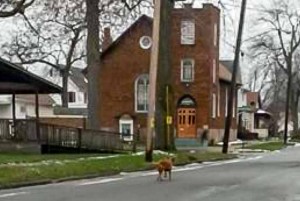
Lollie on the run in Niagara Falls
It took Lollie just eight days to find a chance to sneak out the door and begin her long journey back to the only home she’d ever known. Of course Lollie had no idea how many miles stretched between Niagara Falls and the Bahamas, or just how different the climates were. However, sometimes there is a bond too strong for even distance to break, and such was the case with Lollie and Chella. Lollie wanted to go home, and that was what she was determined to do!
Many volunteers put in countless hours to paper the city of Niagara Falls with flyers and monitor and bait humane traps. Citizens dutifully called in dog sightings around the clock. Finally, after a particularly cold and snowy day that hampered her usual foraging for food, Lollie was tempted by the trap set behind Ventry’s pizza, baited with freshly roasted chicken. Within 24 hours, Lollie’s “Mom” Chella was on a plane bound for New York, anxious to once again lay hands on her beautiful golden fur.

Lollie in the trap
https://www.facebook.com/The-
Niagara Falls News
American Falls Erosion Issue Reviewed 49 Years Ago
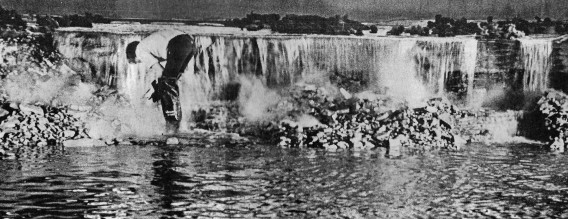
In 1967 the International Joint Commission, which was formed in 1910 by both the United States and Canada to oversee problems along the 3000 mile mutual border, began a process to determine what could be done to address the erosion issue with the American Falls. The Commission created The American Falls International Board and two years later that board initiated the famous “de-watering” of the American Falls to allow an up close examination of the problem. However, some 80 miles north a much smaller model of the Falls was created to give geologists and engineers a hands on approach to fixing the problem.
A model which was 1:50th scale of the American Falls was constructed at the Islington laboratory of the Hydro-Electric Power Commission of Ontario near Toronto. The team looked at three kinds of physical change to be made to the American Falls and the cost associated with each change.
The three choices were:
1. To remove the fallen rock from the base of the American Falls. This would require de-watering the American Falls for one or two tourist seasons. The estimated cost: $1 million to $10 million , depending on the amount of debris removed.
2. To increase the flow over the American Falls by excavating rock in the channel leading to the American Falls and installing control gates. This would require de-watering the American Falls for one season. The estimated cost: $6 million.
3. To restore the level of the Maid of the Mist Pool to the earlier condition by building a submerged structure a few miles downstream of the Falls. The estimated cost: $8.7 million.
The commission distributed 220,000 brochures in 1973 with ballots on both sides of the border to obtain a public consensus of what should be done about the talus of the American Falls. The ballots contained the three proposed options for the American Falls and participants were asked to mail their completed ballots to destinations in Burlington Ontario and Buffalo New York.
Two years later, in 1975, the International Joint Commission presented the conclusions reportedly determined by the completed ballots and their own study and made recommendations in a report entitled “Preservation and Enhancement of the American Falls at Niagara. This was their findings:
The talus at the base of the American Falls is estimated by engineers at 358,000 tons (280,000 cubic yards) with the talus reaching 135 feet (41M) high in places reducing the water fall from 100 feet (30m) to a mere 45 feet (13.7M). The depth of the talus ranges from 25 feet (7.6m) to 50 feet (15m).
The talus was accumulated as a result of major rock falls in January 1931, July 1954 and December 1959 which cumulatively deposited approximately 130,000 cubic feet of talus at the base of the American Falls.
During the de-watering process, tests included 46 core borings totaling 4,882 feet (1488m). In addition to various mapping and probing processes, piezometers were installed to measure water pressure on rock joints and extensometers to measure rock movements.
The public response was overwhelming. Five thousand prepaid cards were returned along with 70,000 other replies. The conclusion of this process was that a majority of respondents chose to not change the American Falls.
The International Joint Commission came to five basic conclusions:
- while it is technically feasible to remove the talus which has collected at the base of the American Falls, it is not desirable to do so at the present time
- while structural solutions are available to arrest erosion at the crest of the American Falls, the Falls should not be stabilized by artificial means
- a broad environmental study should be jointly carried out by Canada and the United States to identify and give priority to those measures which best enhance the total setting and beauty of the Niagara Falls area
- that the two flanks of the American Falls and the Goat Island flank of the Horseshoe Falls are sufficiently unstable to warrant remedial action …
- a statistically minor element of risk from unpredictable rock movement will remain and must be accepted by the viewing public.
At the end of the 8 year process no debris or rocks were removed from the base of the American Falls. The face of the gorge that made up the American Falls was reinforced with long metal rods to slow the erosion of the Falls. It was also determined that the reduction of water flow over the American Falls by the International Water Control Dam, which was built in 1954, slowed down the amount of erosion that was occurring with the American Falls.
asdNiagara Falls News
American Falls Could Be “Shut Off”, Again
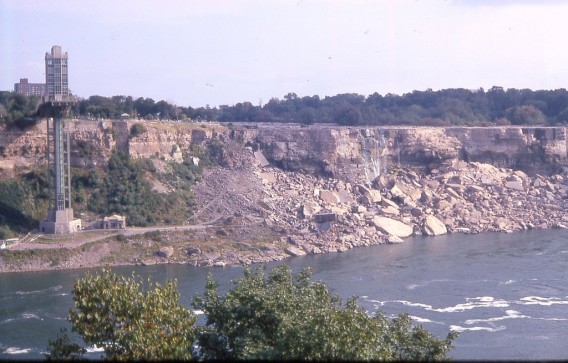
The American and Bridal Falls could be “shut off” like they were in 1969 if a proposed plan to repair two stone bridges connected to Goat Island is approved. The New York State Parks system needs to repair the stone bridges that connect the mainland to Green Island and Green Island and Goat Island. To do that the State will be proposing that the flow of water over the American and Bridal Falls be halted during construction.
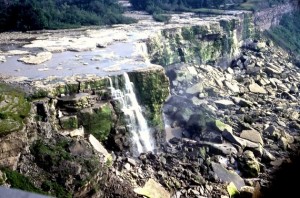
American Falls “shut off”
In the 1960’s concerns grew over the steady erosion of the American and Bridal Falls. It was decided that the flow of water would be stopped in order that the face of the Gorge cliff could be examined. So the flow was stopped on June 12th 1969 by the Army Corp of Engineers.

Construction of Cofferdam
A cofferdam was constructed by Sevenson Construction on June 12th and removed on November 25th after it was decided that the huge mound of boulders at the base of the American Falls were in part holding up the cliff face. So the Engineers decided to do some “minor” reconstruction and securing of the rock bed.
Now the State needs to shore up and repair the two stone and concrete pedestrian bridges and it is very possible that once again the flow to the American Falls will again be damned off.
The three proposals that the State will be discussing at the public hearing Wednesday at the Niagara Falls Conference Center are as follows in the order of preference:
• Standard two-year construction which would divert water from the American Falls for five months in the first year, from August to December. The bridges would be demolished and new piers would be anchored to the bedrock. Piers and abutments must be constructed on a dry bed to ensure the foundations are firmly anchored to the bedrock. The river channel must also be dewatered in order to demolish and remove the bridges. Water flow would be restored in late December. Construction would continue in the second year, but the falls would not need to be dewatered again while construction continues in the second year.
• Accelerated construction scenario, which would be completed in one year. This option would divert from the American Falls for nine months, from April through December. It would affect the entire summer tourism season and require 24-hour-a-day construction. There is the potential for significant delay if the project falls behind schedule and is shut down in the winter.
• Extended construction scenario, a three-year plan. This option has already been eliminated for all practical purposes and without further study due to its high cost and the impact of a three-year timetable. But, as presented, the plan would eliminate the need to divert water from the American and Bridal Veil Falls by relying on a series of partial cofferdams. The river bed would be partially dewatered with flow maintained in other sections.
When the Falls were “shut off” in 1969 they became a tourist attraction in their own right and that was well before social media or even the use of video tape or recording devices. Should the Falls again be damned and shut-down for an extended period of time the images and video would be viewed world-wide and undoubtedly draw millions to view this rarity in person.
asdNiagara Falls News, Niagara Falls Sights
Winter Weather Finally Coming to Niagara
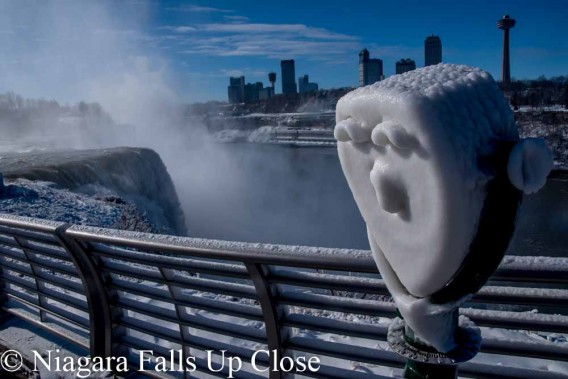
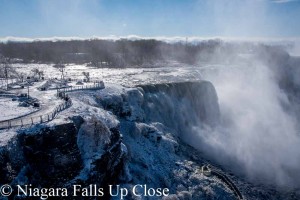
Winter finally sets in at Niagara Falls
Niagara Falls is a glorious sight in the summer, but the frigid winds of winter create a spectacle of wonder. The current conditions have been relatively mild for this time of year, but temperatures in the teens are finally producing some of the frozen scenes around the Falls natives have grown accustomed to.
The winter of 2015 had historic snow falls and cold temperatures. So much so that Niagara Falls drew thousands of tourists in what is normally a slow time of year. People drove hundreds of miles to see Niagara Falls “frozen” and many have been waiting for a return trip in 2016.
With the warmer than usual autumn and December it’s unlikely the Falls will create the huge pillars and mountains of ice that were formed last year. However, the constant mist around both the Horseshoe and American Falls have already painted a frozen landscape near the brink that Jack Frost would be proud of.
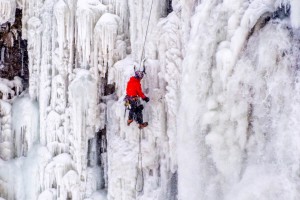
Will Gadd next to the Horseshoe Falls
In January of 2015 world famous ice-climber Will Gadd made a historic ascent along side the Horseshoe Falls that was captured right here at niagarafallsupclose.com. The video and still photos where viewed worldwide, but Gadd would have been out of luck if he had tried it this month.
It is possible if the area is hit with a week or two of near zero temperatures that ice will accumulate in large quantities around the Falls, but so far it looks like fans of a frozen Niagara may have to wait until next year.
asd




